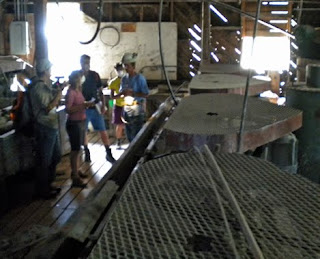When thinking about mining it is often difficult to adjust down from the industrial to the human scale. The Ute Ulay Mine is no exception. Yesterday, Becky wrote an informative account of the group’s visit to the Ute Ulay Mine with Matt Ingram. I would like to continue musing about that experience from a different perspective. How do historic industrial sites such as the Ute Ulay function symbolically within our culture.
In the west, the industrial age is definitely over. Much of our production and economy has been either altered by automation or moved off shore. As fewer and fewer of us do physical work, there is a romanticization of labor. The post-industrial age tends to look back to that time as an uncomplicated, golden age of clarity and hard work. This attitude often generates a view of history that can be best described as nostalgia. When history becomes a vehicle for escape and not a living covenant with past generations it is robbed of its richness and integrity.
Matt Ingram tour Guide extraordinaire
Our journey with Matt Ingram through the labyrinthine Ute Ulay Mill was a refreshing reminder that the mine is far more then a static icon. The stacked floors of wheels, belts and engines were the platform for an on-going performance. The choreography of people and machines was and continues to be an intricate dance. The Buck Eye might be a stunning engine but it took knowledge, precision, and a sense of humor to get it started. Mr. Ingram obviously loves his work and was able to communicate his engagement in the Mining industry.
The history of the Ute Ulay mine reaches back to the time of Manifest Destiny. It is an icon of resource extraction and the politics of power. Yet it is also a living place were the community can chart a course that embodies its shifting relationship with the land. As we move forward, it will be a challenge to honor the past and look toward the future.



No comments:
Post a Comment